| |
|
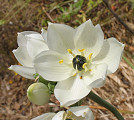 | |
| MaltaWildPlants.com by Stephen Mifsud |

|
| |
|
|
 |  |  |  |
| External Links: |
|
Oxalis stricta (Yellow Wood Sorrel) |
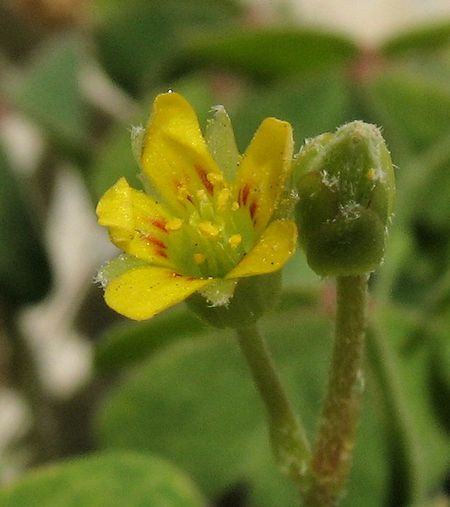
Oxalis stricta (OXALIDACEAE.)
Images for this profile are taken from the Maltese Islands after year 2000. |
|
| Nomenclature |
Species name : | Oxalis stricta L. | Authority : | Carl von Linne, Sweden, (1707 - 1778) | Synonyms :
(basionym or principal syn.) |
|
Plant Family : | Oxalidaceae R. Br.
(WoodSorrel Family) | English name(s) : | Yellow Wood Sorrel, Upright Oxalis, Upright Wood Sorrel | Maltese name(s) : | Ingliża Wieqfa | Status for Malta : | Persisting Alien. Introduced species for horticulture (flowering plants) or agriculture (herbs or fruiting trees)
usually within the last 2 centuries and persist after their original location or site is abandoned.
They do not widespread but usually remain as a single tree or a very localised population. | Name Derivation : |
Oxalis: sour, acidic, or acrid-tasting, referring to the sour taste of the sap due to the high level of Oxalic acid that is present in most species, especially in the stems, leaves and roots. (Greek origin ); 2 = derived from "sour", due to oxalic acid in leaves and roots (Greek);.
stricta: 1 = pertaining to springs or fountains, growing in fast-running water (Latin).
| Remarks : | |
|
| Morphology and structure |
PLANT STRUCTURE: |
Character | Growth Form | Branching | Surface |
Description | | | |
General
Picture | 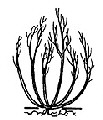 |  | 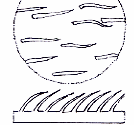 |
|
LEAVES: |
Character | Arrangement | Attachment | Venation |
Description | | | |
General
Picture |  | 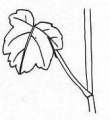 |  |
| |
Character | Leaf Shape | Leaf Margin | Remarks |
Description | | | Leaf Pigmentation Unlike O. pes-caprae and O. corniculata, the leaves show no pigmentation and hence are all green. |
General
Picture |  |  |  |
|
FLOWERS: |
Character | Colour | Basic Flower Type | No. of Petals | No. of Sepals |
Description | Yolk-yellow | | 5 | 5 |
General
Picture | | 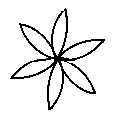 |  |  |
| |
Character | Inflorescence | Description | Ovary | Stamens |
Description | | Simple and perfect actinomorphic flower composed 5 narrow sepals, 5 yellow petals (alternating with sepals) and a set of 10 stamens arranged in 2 whorls of 5 each and situated around a central minute ovary. Petals may have 1 to 4 small, linear, brownish steaks at their base. | | |
General
Picture |  |  | 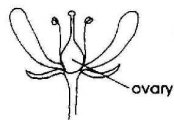 |  |
| |
Character | Scent | Average Flower Size | Pollen Colour | Other Notes |
Description | None (or too faint to be detected). | 5-10mm | Yellow | - |
|
SEEDS: |
Character | No. Per Fruit | Shape | Size | Colour |
Description | 35-50 | Flattened & ovate (looks like a trilobite under the microscope). | 1mm | Reddish Brown |
General
Picture |  |  |  |  |
|
FRUIT AND OTHER BOTANICAL DATA: |
Character | Fruit Type | Colour of Fruit | Subterranean Parts | Other Notes |
Description | | Green The fruit is still fresh during its mechanical method of seed dispersion. | | - |
General
Picture |  |  |  |  |
|
|
| Plant description and characters | |
Life Cycle: | Perennial. |
Growth Form: | HEMICRYPTOPHYTE (prostate plants with flowers close to the ground) |
Habitat: | Cosmopolitan herbaceous plant found along pavements, streets and building edges. |
Frequency: | Rare |
Localities in Malta: | Location remains undisclosed for protecting the plant. |
Plant Height: | 20cm. |
| Apr-Jul |
Protection in Malta: | Not legally protected till the last update of this website (2/Mar/2022) |
Red List 1989: | Not listed in the Red Data Book of the Maltese Islands |
Poison: | |
This is a recently introduced plant, so far habiting in urban localities at the NorthEast coastal area of Malta. The few specimen found, were all lying as ascending to sub-erect plants on the pavement or building sides. The perennial plant tend to form isolated populations. A long and slender taproot forms green or reddish-brown stems that can grow to 30 cm long or even more. Stem branching does not usually take place, or confined to the basal part or more often to the flowering part. There are numerous, long-stalked leaves along the trailing stem outgrowing in pairs (from same stem node) or in few-numbered whorls. Rooting from stem nodes do not occur and underground bulbils are not produced.
The plant is perennial due its living rooting parts.
Leaf stalks are between 3-5cm long holding a terminal trefoil - a compound leaf composed of 3 identical leaflets. Each leaflet consists of a heart-shaped structure joined to the stalk apex from their pointed part. On average, each leaflet is 15mm wide and 10mm long. The leaves are green, without any purple coloration or blobs as in other wild Oxalis members in Malta. The outline is ciliated, but the lamina is generally glabrous.
Towards the upper flowering part of the stem, the leaves are somehow more numerous, smaller and with shorter stalks. At irregular intervals, flowering stalks (peduncles) outgrows from this upper part of the stem. Each peduncle gives rise to a few-flowered cyme, usually made up of 2, 3 or 4 flowers only. Flowers of the same cyme have pedicels of about. 10mm and blossom at different times.
In Malta, the flowers have a short blossoming daytime, being from morning till noon. It is uncertain if this is a general characteristic, or restricted to the specimen population that research was made upon related to its particular micro-habitat. Each actinomorphic flower measures between 5 to 10mm and is basically composed of 5 free, pale green sepals alternating with a set 5, yellow petals. Petals are longer than sepals. There are 10 stamens arranged into two rows of 5 each, where one row is situated over the other. The stamens encircle the central pistil which consists of a simple and small style and stigma. Ovary superior and hidden.
Unlike its abundant relative (Oxalis pes-caprae), Oxalis fontana forms fruit capsules and seeds. The fruit shape can be described as an elongated conical structure where the central part is linear. It can measure upto 2cm in length. The capsule has a unique method of mechanical seed dispersion. Longitudinal slits are present along the capsule through which tiny, brown seeds are ejected out at a considerable distance at periodic intervals. It may take a couple of days until all seeds are dispelled out from the fresh, green capsule. Touching or rubbing the mature fruit speeds up seed ejection.
The tiny, reddish-brown seeds are barely 1mm long and under a magnification glass, they are seen to have transverse parallel ridges. Seeds are flattened, egg-shaped with one hemisphere being more obtuse (curved up) from the other, giving a far impression of a trilobite structure!
|
|
| Information, uses and other details |
Nativity and distribution
Plant originates from North America and Asia. [WWW-21, WWW-160]. Yellow wood sorrel is a native North American plant (also found in Eurasia) which may grow either as an annual or as a perennial. [WWW-164]. It was brought to England in 1658 as an ornamental plant and spread during the 19th century across Europe. Oxalis fontana can be found in fresh clay soils, in fields, at the side of the path, in gardens and in cemeteries. [WWW-160]. Oxalis fontana has spread throughout Europe, from Scandinavia to Spain, east to Italy and Poland. It has been naturalized in Britain [KF]
Notes about Oxalis (from freedictionary.com)
Oxalis is the largest genus in the wood sorrel family Oxalidaceae. Of the approximately 900 known species in the Oxalidaceae, 800 belong to Oxalis. Many of the species are known as Wood Sorrel or Woodsorrel. The genus occurs throughout most of the world, except for the polar areas; species diversity is particularly rich in tropical Brazil and Mexico and in South Africa. [WWW-70]
These plants are annual or perennial. The leaves are divided into three to ten or more round, heart-shaped or lanceolate leaflets, arranged in a whorl with all the leaflets of roughly equal size. The majority of species have three leaflets; in these species, the leaves are superficially similar to those of some clovers, though clovers differ in having the leaflets not in a whorl, and of unequal size with two smaller side leaflets and one larger central leaflet. The flowers have five petals, usually fused at the base, and ten stamens; the petal colour varies from white to pink, red or yellow. The fruit is a small capsule containing several seeds. The roots are often tuberous, and several species also reproduce vegetatively by production of bulbils, which detach to produce new plants. [WWW-70]
Notes about Oxalis (from quattrofolium.com)
The main genus of the Wood Sorrel family is Oxalis, which has some 800 sorts. The genus owes its name to the embedded calciumoxalate-crystals (oxalic acid). The plants of this genus really grow everywhere on our planet. Especially rich in genera are the Andes, the tropical regions of Brazil, Mexico and South Africa. [WWW-160]
In this group are both annual plants and perennial shrubs. The oxalis plants are not of any economic significance. In former times, oxalis acetosella was used in the Black Forest to produce out of a weight of 75 kg leaves and amount of 500 g oxalic acid for technical purposes. [WWW-160]
The cloverleaf is also born as the heraldic emblem on the Irish coat of arms. It used to be eaten as salad or side dish due to its somewhat sour taste. People living in the Andes eat the root tubercules and the oxalis tuberosa's stems which are above ground. These large tubercules which are rich in starch are a called "oca" and still represent a very important basic food of the population there. We mistakenly call oxalis deppei "four-leaved clover" as it actually has four leaves like ours. This sort, originating from Mexico, was imported in 1822 and belongs to the sorts which are not hardy. Those bulbs that have been propagated by means of a complicated procedure are designed for being sold in October. 95% of these ornamental plants sold are put up to sale during the weeks before Christmas and the days before New Year. [WWW-160]
Notes about Oxalis (from wikipedia.com)
Oxalis is the largest genus in the wood sorrel family Oxalidaceae. Of the approximately 900 known species in the Oxalidaceae, 800 belong to Oxalis. Many of the species are known as Wood Sorrel or Woodsorrel. The genus occurs throughout most of the world, except for the polar areas; species diversity is particularly rich in tropical Brazil and Mexico and in South Africa. [WWW-60]
These plants are annual or perennial. The leaves are divided into three to ten or more round, heart-shaped or lanceolate leaflets, arranged in a whorl with all the leaflets of roughly equal size. The majority of species have three leaflets; in these species, the leaves are superficially similar to those of some clovers, though clovers differ in having the leaflets not in a whorl, and of unequal size with two smaller side leaflets and one larger central leaflet. Some species exhibit rapid changes in leaf angle in response to temporarily high light intensity. The flowers have five petals, usually fused at the base, and ten stamens; the petal colour varies from white to pink, red or yellow. The fruit is a small capsule containing several seeds. The roots are often tuberous, and several species also reproduce vegetatively by production of bulbils, which detach to produce new plants. [WWW-60]
Medicinal Uses
This wood sorrel was used to treat cancer and in general, Oxalis species have been used orally for liver and digestive disorders. Nowadays, this species is not commonly used as a medicinal herb. American Indians ate wood sorrel, and the leaves were used as a treatment for scurvy. As scurvy is caused by a deficiency of vitamin C, found in most green plants, this treatment should have been effective. [WWW-161] An infusion of the plant has been used in the treatment of fevers, stomach cramps and nausea[257]. A poultice of the plant has been used to treat swellings[257].
Medicinally, in moderate dosages, wood sorrel is cooling (refrigerant, febrifuge), diuretic, stomachic (soothing to the stomach, relieves indigestion), astringent, and catalytic. It's also attributed with blood cleansing properties and is sometimes taken by cancer patients [WWW-164]
Propagation and Cultivation
Easily grown in a sandy soil in a warm dry position [1]. Seed is best sown as soon as ripe in a cold frame. Prick out the seedlings into individual pots when they are large enough to handle and plant them out in late spring or early summer. [KF] Plant prefers half shade[WWW-160] and sandy loam soil with a pH ranging from acid to alkaline with little to moderate amounts of moisture. [WWW-165] It is self fertilezed since of its hermaphrodite flowers that get pollinated by themselves. [WWW-165] This reference states that it likes full sun but [WWW-164] states that wood sorrel prefers moist soil, and partial shade. The specimen encountered in Malta where in a habitat that had partial sunlight (a rough estimate of 40% of total daylight).[SM]
This delicate looking plant forms colonies which arise from slender but tough underground stems (rhizomes). [WWW-164]
Edible Uses
References for synonym O. europaea mentions the following edible notes: The leaves were eaten raw or cooked [61]. This gives a pleasant acid flavour, and so it makes an excellent addition to mixed salads [KF].
References for another synonym - O. stricta, mentions the following edible uses: Raw or cooked leaves were earen [46, 61, 105]. Having a nice acid flavour [159], the leaves were chewed as a thirst quencher [183]. Raw flowers were also consumed mostly in decorative salads [105, 161, 183]. Raw young seedpods [183] and roots [105, 161, 183] have been mentioned to be eaten too, but no further details were given [KF]. A lemon-flavoured drink is made from the leaves [159].
Edible documentation directly for O. fontana are currently not found [SM]
The sour-tasting leaves can be used as an addition to salads, or can be steeped in boiling water for 5 to 10 minutes, cooled, and then sweetened with sugar or honey to make a cold drink. [WWW-163].
Yellow wood sorrel is wonderfully thirst quenching and refreshing to eat. The leaves, flowers, and immature green seed pods are all edible, with a sour, lemon like flavor. It's a fine thing to find along the trail, which is how I generally eat it, but it can also be added to salads, used in soups (the same way as garden sorrel), used in sauces (traditionally served with fish), or used as a seasoning. A chilled, sweetened, wood sorrel tea makes a refreshing beverage along the lines of lemonade. Wood sorrel is quite high in ascorbic acid (vitamin C) and may provide other nutrients. [WWW-164]
Other Uses
The Meskwaki boiled the whole plant to obtain an orange dye. [257]
Toxicity
Wood sorrel contains 0.3 to 1.25% oxalic acid (NMCD 2000). Oxalic acid combines with calcium forming calcium oxalate in the gastrointestinal tract or the urinary tract in the bloodstream. This may damage the kidneys, leading acute kidney failure. Oxalates have no therapeutic use [WWW-161]. The leaves contain Oxalic acid, which gives them their sharp flavour. Perfectly all right in small quantities, the leaves should not be eaten in large amounts since oxalic acid can bind up the body's supply of Calcium making it unavailable, and so leading to nutritional Calcium deficiency. The quantity of oxalic acid will be reduced if the leaves are cooked. People with a tendency to rheumatism, arthritis, gout, kidney stones or hyperacidity should take especial caution if including this plant in their diet since it can aggravate their condition [238].
For a detailed report about OXalate poisoning, please click the following links:
Oxalate poisoning by Kimberly Page
Oxalate poisoning by Mary C. Smith.
Oxalate poisoning from Wikipedia.
Oxalate poisoning from emedicine.com
Leaf Folding
Wood sorrel folds its leaves up at night and opens them again in the morning. It also folds its leaves when under stress, such as when growing in direct sun, or during storms. [WWW-164] Could be possible also under strong sunshine and lack of water stress.(?) [SM].
Weed control
Oxalis fontana is another of the primary targets of various broad-leaf herbicides, however herbicides are not very effective on Oxalis species unless used prior to emergence, in which case they'll keep other desirable seeds from sprouting as well. Control is probably best accomplished by hand weeding and mulching where possible. [WWW-164]
Personal Observations
Closely related species
The highly variable Oxalis corniculata may be easily mistaken with the Oxalis fontana. The table below show the major differences between the two species as observed in Malta. [SM]
| Feature |
Oxalis corniculata |
Oxalis fontana |
| Growth form |
Creeping |
Ascending to sub-erect |
| Leaf arrangement_ |
Alternate |
Opposite or in whorls of few leaves arising from stem nodes |
| Rooting at stem nodes |
Present |
Absent |
| Leaf Stipules |
Small but well visible |
Minute, often absent |
| Fruit stalks (pedicels) |
Recurved |
Variable, mostly straight. |
| Leaf colour |
Leaves often have a purple or maroon coloration, sometimes the entire plant is so. |
Specimen encountered in Malta had green leaves without any trace of violet coloration (except stems). |
The plant is a perennial due to its underground stolons [WWW-21], or/and slender rhizomes.[WWW-164] Yellow wood sorrel (O. fontana) may be distinguished from Creeping red wood sorrel (O. corniculata) by the presence of underground rhizomes versus the above-ground stolons of creeping red wood sorrel. Also, creeping wood sorrel has a more prostrate growth habit and often has more reddish-purple leaves than yellow woodsorrel. [WWW-162]. Yellow wood sorrel is distinctive from other wood sorrels in that the seed pods bend sharply upward on their stalks, and the stalks also grow at a sharp angle from the main stalk (both angles are about 90 degrees). Another reference [WWW-164] also states that O. fontana tends to grow in a more upright fashion than other wood sorrels (stricta means "upright"). [WWW-164]
Flowering Time
The normal flowering time is observed to be during Spring. However, in certain shady habitats where water is available (see next chapter), the plant thrives during summer and keeps its flowering process along most of Summer. [SM]
Habitat in Malta
The 3 or 4 specimen encountered in Malta all had the same habitat - edges of pavements or building walls. The plant enjoys watering from house or car washing during summer, hence their preferred cosmopolitan habitat. To my belief, washing water flow down and finds itself into small gaps, cracks or holes in the pavements or streets, which is use by the plant to survive summer. Maybe it is not very fastidious to soap ?! [SM]
Seed dispersion
Unlike Oxalis pes-caprae, O. fontana as well as O. corniculata forms fruiting capsules and fertile seeds. Both plants have a similar method of mechanical seed dispersion. The interesting fact is that seeds are ejected out while the fruit is still fresh and green. The fruit does not split open but it is a poricidal type of capsule, where there are few slits along the 5 longitudinal ridges in the fruit wall. Seeds are seen ejected out through these pores at a considerable speed. Rubbing or touching the fruit will accelerate the seed ejection. This keeps taking place gradually over a period of 2-3 days. When all seeds are liberated the pod is still fleshy and green. Fresh seeds seemed to repel each other out when placed close to each other for digital image scanning purposes. [SM]
|
|
| Links & Further literature
(1 papers) |

Google Web |

Google Images |

Google Scholar |

Research Gate |

Wikipedia |

JSTOR |

GBIF |

Med Checklist |

Cat. of Life |

EoL |

IPNI |

World Flora Online |

Plants of the World Online |

Vienna Virt. Herb. |

RBGE Herbarium |

KEW Herbarium |

MNHN |

Arkive |

IUCN |

CABI |
 |
Updates in the Flora of the Maltese Islands (Central Mediterranean) |
Stephen Mifsud (2007) |
Kindly Email if there are papers and publications about local
studies or information about this species to be included in the list above.
|
| Photo Gallery (28 Images) | 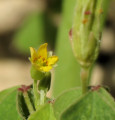 |
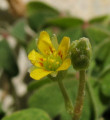 |
 |
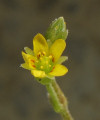 |
IMAGE: OXLST-01 Photo of the small, yellow flower of this Wood Sorrel (Oxalidaceae) plant. |
IMAGE: OXLST-02 Close up photo of the actinomorphic flower. It is composed of 5, free sepals and 5 free yellow petals with small iodine-brown streaks at their base. |
IMAGE: OXLST-03 Close up photo of flower. The plant forms flowers in Spring till mid-Summer in certain shady habitats. |
IMAGE: OXLST-04 Close up photo (top view) of flower showing clearly how the sepals alternate with the petals. |
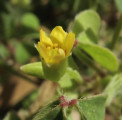 |
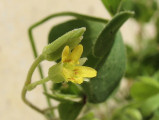 |
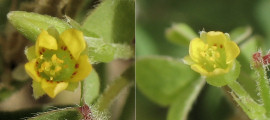 |
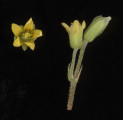 |
IMAGE: OXLST-05 Side-view photo of flower in situ. |
IMAGE: OXLST-06 Photo of flower and a young fruit capsule. The inflorescence is a few-flowered cyme. |
IMAGE: OXLST-07 Two photos of different flowers showing the variation in the number of brown streaks at the base of the petals. This varies between a maximum of 5 streaks per petal to none at all. Usually, there are 4. |
IMAGE: OXLST-08 Scanned image of the flowering parts, including a top view and a lateral view scan. Note the pubescent-pilose pedicel and flower stalk. |
 |
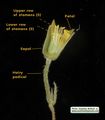 |
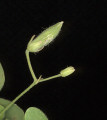 |
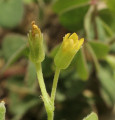 |
IMAGE: OXLST-09 Enlarged scanned image of flower showing the corolla parts (5 sepals + 5 petals) and the central stamens - total of 10. |
IMAGE: OXLST-10 Scanned and annotated diagram of a longitudinally dissected flower. This image shows how the 10 stamens are grouped in two rows of 5 each; situated over each other. Some reports states that the lower row is not fertile. |
IMAGE: OXLST-11 Scanned image of bud and small fruit. The flowers of each inflorescence blossom periodically at different times. |
IMAGE: OXLST-12 Photo of young flower just before blossoming. In July, it was observed that flowers close in the afternoon, (...and the leaves fold inwards). |
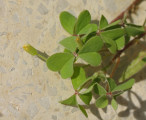 |
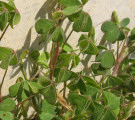 |
 |
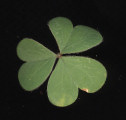 |
IMAGE: OXLST-13 Photo of the numerous petiolated leaves which are more dense towards the flowering part of the stem. Leaves of specimen encountered were entirely green without any purple coloration or blotches as other Oxalis species in Malta. |
IMAGE: OXLST-14 Photo of the upright leaves and stems of the plant. The individual leaflets are heart-shaped (= cordiform). |
IMAGE: OXLST-15 Close up photo of leaf margin showing its ciliated outline. The rest of the leaf blade is glabrous. |
IMAGE: OXLST-16 Scanned image of a leaf. The plant has compound leaves made up of 3 leaflets (trifoliate). Each leaflet has a heart shaped structure and held to the stalk from their 'tip' (pointed part), and hence, the leaflet shape is sometimes referred to as an inverted cordiform. |
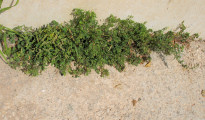 |
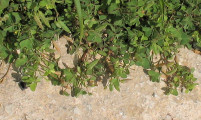 |
 |
 |
IMAGE: OXLST-17 Photo showing one of the most common habitat of this cosmopolitan plant. It is found growing through gaps in pavements and building sides. |
IMAGE: OXLST-18 Photo of plant which does not grow very high, forms numerous leaves, and often found in dense but small populations. |
IMAGE: OXLST-19 Photo of plant having true stems (often reddish-maroon colour) and found upright or ascending up. They are not entirely creeping as Oxlais corniculata). |
IMAGE: OXLST-20 Annotated photo of a plant showing its main parts. |
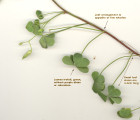 |
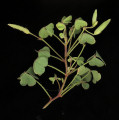 |
 |
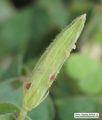 |
IMAGE: OXLST-21 Scanned image of lower part of stem. One important characteristic of this plant is the leaf arrangement. Leaves are arranged in (sub-)opposite pairs or few-numbered whorls outgrowing from stem nodes. |
IMAGE: OXLST-22 Scanned image of upper part of stem - the flowering part. Leaves are smaller, shorter stalks, but numerous. Flower cymes grow from leaf/stem nodes. |
IMAGE: OXLST-23 Photo of fruit capsule having an elongated conical structure with 5 longitudinal ridges, Since the capsule does not split open, it can be described as poricidal, non-dehiscent capsule, where seeds are liberated through slits along the length of the fruit. |
IMAGE: OXLST-24 Photo of a fresh mature fruit capsule with tiny seeds ejecting out. The seed dispersal mechanism is rather complex for this non-dehiscent capsule. |
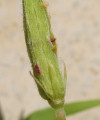 |
 |
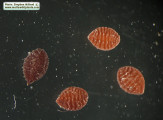 |
 |
IMAGE: OXLST-25 Close up of lower part of fruit showing the persistent 5-sepalled calyx and longitudinal slits through which seeds are ejected out periodically from the fresh green fruit. Seeds ejection is sped up when mature fruit is rubbed. |
IMAGE: OXLST-26 Scanned image of fruit capsule with some tiny (1mm), reddish-brown seeds coming out through openings in the fruit wall. Light coloured seeds are non viable or immature. As seen, the fruit is hairy. . |
IMAGE: OXLST-27 Magnified image of seeds under microscope. They are egg-shaped, reddish brown and just 1mm long. |
IMAGE: OXLST-28 A further magnified image of seeds under microscope showing the detail of the texture of the seed coat. Note the transversal ridges (about 7-8) along the seed. |
|
| | |

